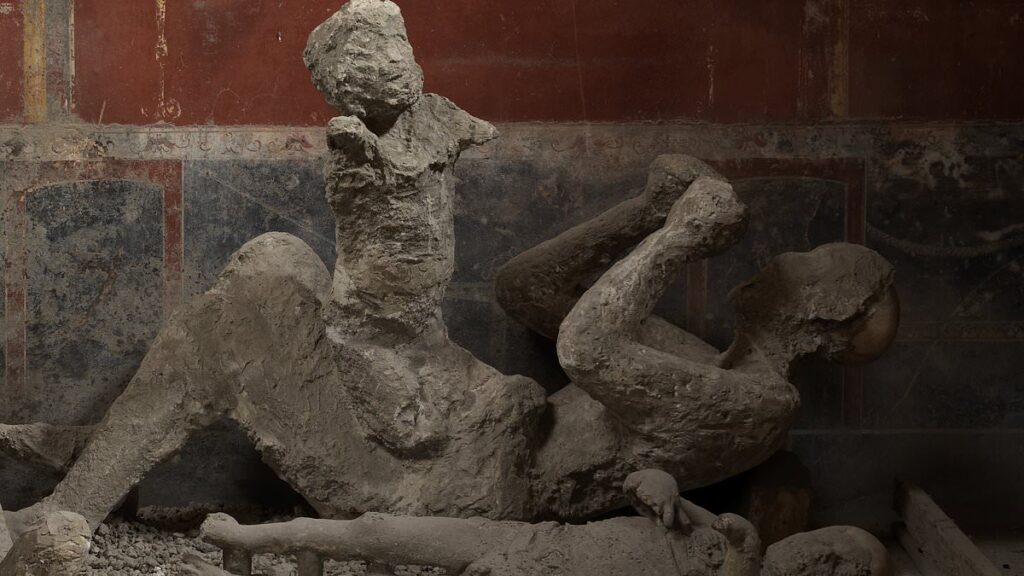New DNA evidence from bodies buried in Pompeii is rewriting common beliefs about the ancient town’s history.
Scientists found that these assumptions, based solely on the physical appearance and positioning of the remains, have been wrong for decades.
One of the more famous plaster casts held the remains of an adult holding a child – that was previously assumed to have been a mother who died with their young in their hands.
But the new analysis found that the larger body belonged to a man who was not genetically related to the child.
And at least one of the two people locked in an embrace – long assumed to be sisters or a mother and daughter – was also a man.
The team said that their analysis clearly debunked ‘the stories that was long spun around these individuals.’

Researchers uncovered four Pompeiian victims in a house that were all believed to be part of one family. They initially thought two of the bodies was a woman with a child on her hip (pictured), but the DNA testing revealed the adult was an unrelated male
Alissa Mittnik of the Max Planck Institute said: ‘We were able to disprove or challenge some of the previous narratives built upon how these individuals were kind of found in relation to each other.
‘It opens up different interpretations for who these people might have been.’
Researchers also confirmed Pompeii citizens came from diverse backgrounds but mainly descended from eastern Mediterranean immigrants – underscoring a broad pattern of movement and cultural exchange in the Roman Empire.
‘Our findings have significant implications for the interpretation of archaeological data and the understanding of ancient societies,’ Mittnik said.
‘They highlight the importance of integrating genetic data with archaeological and historical information to avoid misinterpretations based on modern assumptions.’
Researchers focused on 14 casts undergoing restoration, extracting DNA from the fragmented skeletal remains that mixed with them.
They hoped to determine the sex, ancestry and genetic relationships between the victims.

Two people were discovered in the House of the Cryptoporticus (pictured) and scientists believed two found in a close embrace were two sisters, a mother and daughter or lovers. The new research confirmed that the victims were male and female and one was between the ages of 14 and 19 while the other was 22
There were several surprises in ‘the house of the golden bracelet,’ the dwelling where the assumed mother and child were found.
The adult wore an intricate piece of jewelry, for which the house was named, reinforcing the impression that the victim was a woman.
Nearby were the bodies of another adult and child thought to be the rest of their family.
DNA evidence showed the four were male and not related to one another, clearly showing ‘the story that was long spun around these individuals’ was wrong, Mittnik said.
Researcher also found that the ancient people were descended from ancestors who migrated to region from the eastern Mediterranean, which suggested they had darker features than previously believed.
They were also able to partially reconstruct the appearance of the individuals, finding that one had black hair and dark skin and two others had brown eyes.
This suggested that their ancestors originated from Eastern Mediterranean and North African populations that may have included central and east Turkey, Sardinia, Lebanon and Italy.
The researchers said they still need to conduct more genetic testing to fully understand Pompeii’s past.
The study’s co-author, David Caramelli of the Universita di Firenze said: ‘This study illustrates how unreliable narratives based on limited evidence can be, often reflecting the worldview of the researchers at the time.’
Pompeii was covered in ash when Mount Vesuvius erupted in 79 AD, killing everyone in its path and burying the area.
The town was forgotten until its rediscovery in the 1700s when researchers found dozens of bodies that had been preserved from the soot and ash that covered the streets, buildings and people.
Excavations of Pompeii began in 1748, and although Vesuvius’s eruption completely destroyed the city, the pyroclastic deposits preserved the victims, buildings and art.
The victim’s soft tissue had decayed over the millennia, but their outlines remained intact and were recovered by filling the cavities with plaster, thus preserving their DNA.

A Pompeiian man, believed to be the custodian of a house, was found in an upper room completely alone (pictured)
When the bodies were first discovered, researchers looked at their positioning to each other as well as the location which led to assumptions about their relationships to one another.
During the 1914 Pompeii excavations, nine individuals were discovered in a home’s garden, two of which were found close to each other in an embrace.
At the time, archaeologists said there were three possibilities for their relationship: they were mother and daughter, two sisters or lovers.
After scanning the skeletal remains, researchers have now determined that the victims were male and female and one was between the ages of 14 and 19 while the other was 22.
In another case discovered in 1974, four victims were found at a home and were assumed to be a genetically related family.
The first body was that of a four-year-old who was identified as male due to the bulge in the plaster near his genitalia.










